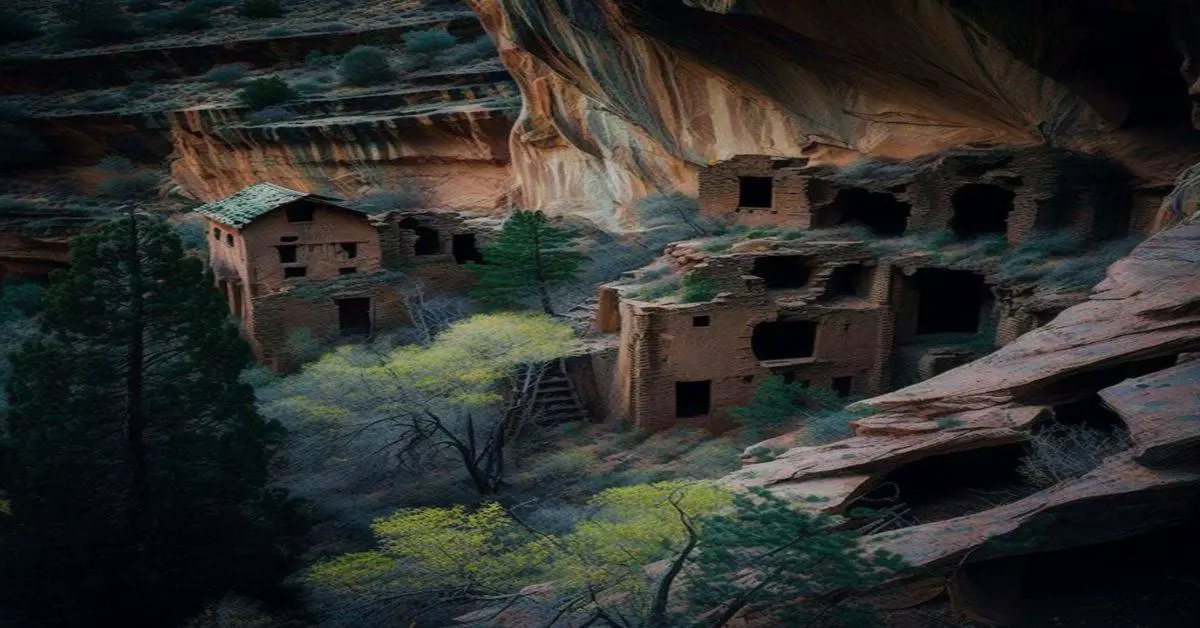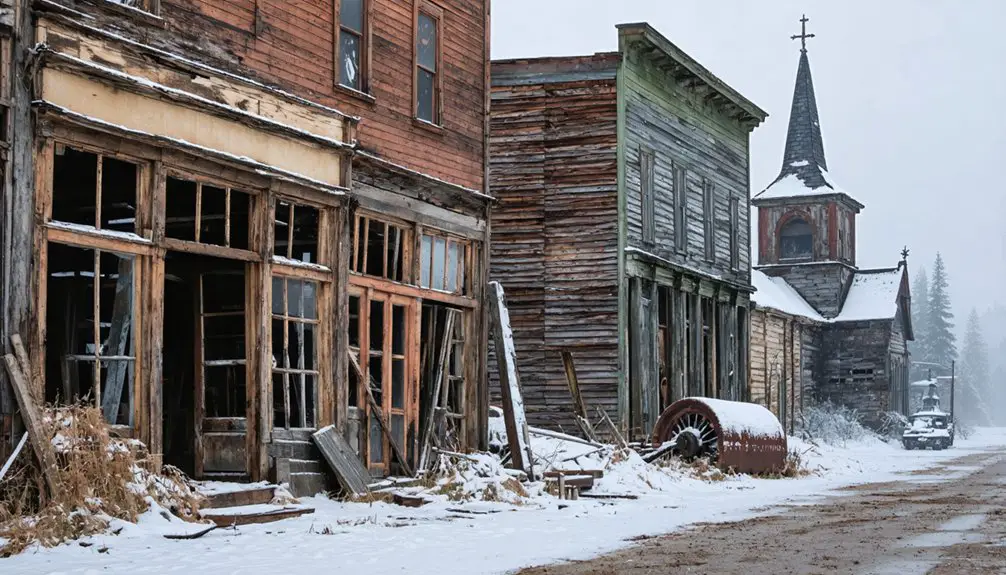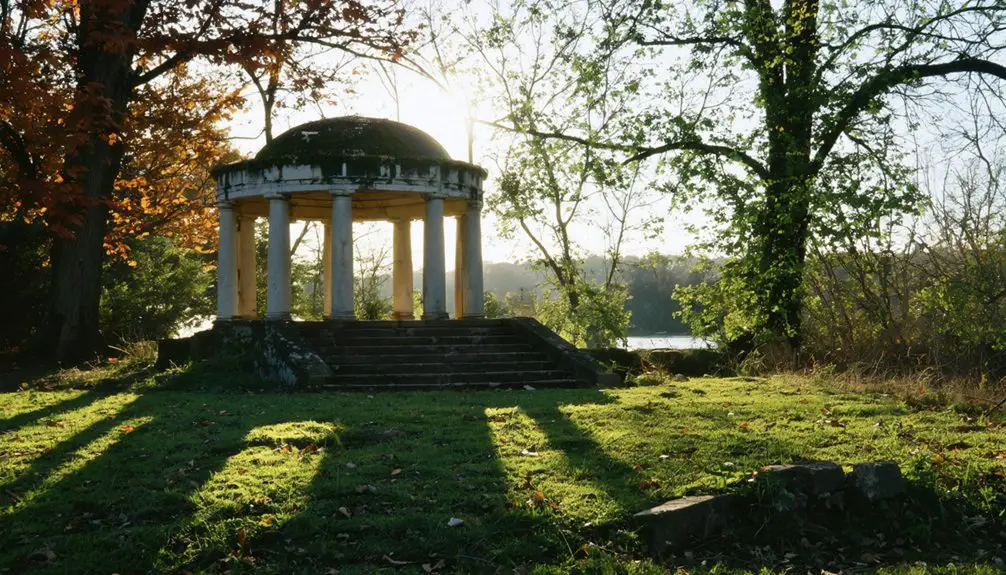You’ll find the abandoned ghost town of Ames in West Virginia’s New River Gorge, where it operated as a coal mining community from 1883 until the early 2010s. Originally named Elmo, the town flourished after the Chesapeake & Ohio Railroad’s arrival, supporting over 60 coal towns in the region. Today, weathered foundations and scattered mining equipment remain as silent witnesses to the once-bustling community’s rich history, while local historical societies preserve its compelling story.
Key Takeaways
- Ames was a coal mining town established in 1883 along the New River Gorge, originally known as Elmo, serving the Chesapeake & Ohio Railroad.
- The town featured company-owned houses, mining infrastructure, and community facilities supporting diverse immigrant miners and their families.
- Social life centered around company stores, churches, and community halls, with workers paid in scrip and strong cultural traditions.
- Ames declined rapidly in the early 2010s when local mines closed, forcing families to relocate due to job losses.
- Today, only weathered foundations and scattered mining equipment remain, with history preserved through limited records and oral histories.
The Rise of a Coal Mining Community
When the Chesapeake & Ohio Railroad completed its tracks through the New River Gorge in 1883, it opened access to West Virginia’s rich bituminous coal seams that had formed over 300 million years ago during the Pennsylvanian period.
The deep gorge canyon carved by erosion over millions of years revealed these valuable coal deposits. You’d find Ames emerging among more than 60 coal towns that sprouted along the gorge, as mining technology advanced and labor rights remained minimal. The railroad’s arrival transformed this remote Appalachian region into a bustling industrial hub, where miners earned about 45 cents per ton extracting high-quality bituminous coal. European immigrants flocked to these mining towns seeking employment opportunities in the growing industry.
This prized coal burned cleanly with little smoke, making it ideal for steel mills and power plants. The company town of Ames became deeply integrated into this new coal economy, with infrastructure including tipples, conveyor systems, and coke ovens.
Life in Early Ames (Formerly Elmo)
Before becoming known as Ames, the small settlement of Elmo took shape in Fayette County, West Virginia, where European Americans had established roots since the late 18th century.
Life in early Ames reflected the cultural heritage of its diverse population, with immigrant miners and their families creating tight-knit neighborhoods around the coal operations. The area’s earliest human activity dated back to the Middle Archaic Period, with artifacts found throughout the region.
You’d find company-owned houses arranged in systematic blocks, where local folklore and community traditions flourished despite the harsh realities of mining life. Much like William Morris in 1774, early settlers established important community foundations.
The railroad defined the town’s southern edge, while company stores controlled the flow of goods and services.
Families gathered at churches and social halls, though daily life centered on the dangerous work underground.
Children attended a modest local school, while their fathers faced the perils of coal mining to support their households.
Mining Operations and Economic Peak
During its peak years, the Ames Mining Company emerged as a powerhouse in West Virginia’s coal industry, extracting valuable bituminous coal from the rich seams of the New River Gorge.
The economic impact rippled through the region as miners earned around 45 cents per ton or $2.00 daily, supporting vibrant mining communities complete with company stores and hundreds of buildings.
Mining wages of 45 cents per ton fueled the growth of bustling coal communities with company stores and worker housing.
You’ll find the evolution of mining technology reflected in Ames’s operations, as they shifted from basic manual extraction to more mechanized approaches by mid-century. The operations were overseen by skilled leaders who rose through the ranks, including those who served as general mine superintendent. The night shift workers maintained continuous production in 1950, ensuring the mine operated at full capacity.
The completion of major rail lines, including the C&O Railroad, proved essential to the company’s success, allowing coal shipments to reach distant markets and ports.
Under leaders like Paul Morton, Ames became a critical supplier to steel mills and power plants throughout the region.
Daily Life of Ames Miners and Families
If you’d visited an Ames miner’s home in the early 1900s, you’d have found a modest company-owned house where families maintained small vegetable gardens to supplement their $2-per-day mining wages.
After grueling 8-10 hour underground shifts in cramped, hazardous tunnels, miners would return home to their families, who relied heavily on community support networks of neighbors and extended relatives.
You’d have seen these close-knit mining families gathering regularly at company-sponsored events, church functions, and ethnic social clubs, where they maintained cultural traditions and found respite from the harsh realities of coal town life.
Working Underground Daily Routines
While darkness enveloped the underground passages of Ames’ coal mines, workers followed strict daily routines that began with early morning entry into the main shafts.
You’d spend your ten-hour underground shifts in near-total darkness, illuminated only by the dim glow of carbide lamps. Working in pairs at the coal face, you’d undercut the bottom edges with picks while lying down, then carefully insert black powder charges after boring holes with a breast auger.
You’d shout “far far in the hole” three times before detonation, positioning yourself against the mine ribs for safety. The intense heat and poor air quality strained your health, leading to breathing difficulties and high blood pressure. During breaks, miners gathered in dinner holes to eat their packed biscuits and bacon.
Despite these harsh conditions, you’d need to meet strict quotas to earn your output-based pay. A strong miner could fill five or more cars during a productive day of loading coal.
Family Housing and Gardens
Life in Ames’ company housing meant sharing a simple one or two-room wooden frame home with your family, clustered tightly alongside other miners’ houses in efficient rows near the mine site.
You’d manage without modern amenities like indoor plumbing or electricity, while your family dynamics revolved around making the most of limited space and resources.
Your garden practices became essential for survival, with every family working their small plot to grow:
- Staple vegetables like potatoes, beans, and cabbage
- Preserves for winter through canning and drying methods
- Shared crops and seeds among neighboring families
You’d rely on your home garden to supplement company store provisions, while women maintained households and children helped tend gardens.
Despite company control over housing, families found independence through their ability to grow food and create self-sustaining practices.
Community Social Gatherings
Despite the demanding nature of coal mining, social gatherings formed the heartbeat of Ames’ tight-knit community. You’d find miners and their families congregating at the company store, community halls, and churches, where social cohesion flourished through shared experiences.
Local musicians livened up evening dances with fiddle tunes, while baseball games drew crowds to cheer for neighborhood teams. Many workers received payment in scrip to spend at the company store, shaping the community’s economic interactions. The diverse mix of immigrants from Europe brought rich cultural traditions to these community gatherings.
The United Mine Workers of America played an essential role in fostering communal celebrations, organizing picnics and educational talks that strengthened solidarity. You’d witness diverse cultural traditions at these gatherings, as immigrant families shared their heritage through food, music, and customs.
During warm months, informal get-togethers near creek banks or in open fields featured storytelling and potluck meals, while church-affiliated events provided year-round opportunities for spiritual and social connection.
The Decline of Local Coal Industry
Since the late 2000s, the coal industry’s decline has devastated Ames and surrounding West Virginia communities, with production plummeting 38% from its 2008 peak.
You’ll find this economic transformation has deeply impacted local families, as mining jobs dropped from over 100,000 to fewer than 20,000, forcing many to leave in search of work elsewhere.
The decline’s severe effects on Ames include:
- Drastic cuts to public services and schools due to reduced coal severance taxes
- Increased rates of health problems, including heart disease and substance abuse
- Loss of generational employment opportunities, with remaining mining jobs paying considerably less than during the boom years
Despite attempts at community resilience, Ames continues to struggle as coal-fired plants face closure and the industry’s downward trajectory persists.
Abandonment and Ghost Town Status

When the local mines ceased operations in the early 2010s, Ames rapidly transformed from a bustling coal town into an abandoned shell of its former self.
You’ll find that the abandonment causes stemmed directly from the town’s dependency on a single industry, with the ghost town evolution following a predictable pattern once mining operations ended. The coal companies, which owned most of the infrastructure, quickly shuttered their company stores and schools.
Without jobs or services, families had no choice but to relocate, leaving their homes behind. As nature reclaimed the land, buildings deteriorated, leaving only foundations and ruins as evidence to the town’s former liveliness.
Today, you can still see traces of Ames’ mining heritage in the overgrown landscape and scattered remnants of its coal-driven past.
Present-Day Remnants and Legacy
When you visit Ames today, you’ll find weathered building foundations, scattered mining equipment, and overgrown railroad beds that hint at the town’s industrial past, though natural vegetation has reclaimed much of the former settlement.
While official documentation about Ames remains limited, making it challenging for historians to piece together a complete picture of the town’s history, local historical societies preserve what records and photographs do exist.
The memories of Ames live on through the oral histories shared by descendants of former residents and through preserved artifacts that tell the story of this once-thriving coal mining community.
Physical Traces Today
Though decades have passed since its abandonment, Ames, West Virginia retains visible traces of its coal mining heritage amid the encroaching forest.
You’ll find stone walls and classroom outlines of old school buildings wrapped in thick vines, while ruined chapels and coal camp housing reveal their foundations through the undergrowth. The area’s industrial past emerges through scattered ruins that invite ruin exploration, though preservation efforts remain limited.
- Mining infrastructure, including sealed shaft entrances and tunnel portals, marks the underground network that once drove the town’s economy.
- Deteriorating coke ovens and spring sites dot the landscape, similar to nearby ghost towns.
- Former community landmarks, from cemetery markers to company store remnants, offer glimpses into daily life in this vanished coal town.
Historical Documentation Challenges
Despite extensive research efforts, documenting Ames’s history presents significant challenges due to fragmented and limited archival materials.
You’ll find that archival scarcity stems from multiple factors: lost company records, destroyed local government documents, and the absence of centralized historical collections specifically about the town.
The community challenges that hindered documentation include the mining company’s tight control over town functions, which limited independent civic record-keeping.
What remains are scattered photographs, like the 1950 Ames Mining Company night force images, and dispersed oral histories from descendants.
The New River Gorge’s rugged terrain and environmental reclamation have further complicated preservation efforts, while overgrowth and natural decay continue to erase physical evidence that could help verify historical accounts.
Community Memory Lives On
While much of Ames’s physical presence has faded into the West Virginia wilderness, you’ll find tangible remnants scattered throughout the New River Gorge landscape. These traces serve as anchors for oral traditions passed down through generations of local families, maintaining essential cultural connections to the area’s coal mining heritage.
- Stone foundations and old mine entrances peek through the forest undergrowth, offering glimpses into the town’s industrial past.
- Local historical societies preserve community memory through regular commemorative events and museum exhibits.
- Family descendants continue sharing personal stories that breathe life into Ames’s history, while nearby towns incorporate these narratives into their visitor centers and educational programs.
The town’s legacy endures through both its physical remnants and the determination of local communities to keep its memory alive.
Historical Significance in Fayette County
The coal mining town of Ames stands as a tribute to Fayette County’s pivotal role in West Virginia’s industrial development during the early to mid-20th century.
You’ll find its economic impact woven deeply into the region’s history, where coal production from towns like Ames powered local and regional growth.
As you explore Ames’s remains, you’ll discover a profound cultural heritage that exemplifies the complex relationship between coal companies and their workers.
The town’s story mirrors countless other company-controlled communities where miners traded personal freedoms for employment security.
Through its abandoned structures and quiet streets, Ames continues to teach valuable lessons about labor history, industrial capitalism, and the true cost of economic dependence on a single industry.
Frequently Asked Questions
Are There Any Paranormal Activities Reported in Abandoned Buildings at Ames?
You won’t find documented ghost sightings or haunted locations confirmed at this site, though similar abandoned mining towns often report unexplained phenomena. Local folklore suggests possible activity, but evidence remains unverified.
What Happened to the Cemetery and Graves of Ames Residents?
Like fading footprints in sand, you’ll find many graves lost to time and nature. Cemetery preservation’s been minimal, with markers deteriorating, locations forgotten, and some burial grounds swallowed by overgrowth or damaged by vandalism.
Can Visitors Legally Explore the Remains of Ames Today?
You’ll need to verify property ownership and obtain permission before exploring, as the area’s likely private property. Without clear public access rights, visiting without authorization could constitute trespassing.
Were There Any Major Mining Accidents or Disasters in Ames?
While mining safety records and accident reports don’t indicate any major disasters directly in Ames, you’ll find several deadly incidents occurred in nearby New River Gorge mines, including Red Ash and Layland disasters.
Did Any Famous People or Notable Figures Come From Ames?
While many coal towns produced notable figures, you won’t find any famous residents or widely recognized personalities from Ames. The town’s legacy rests in its mining history, not individual achievements.
References
- https://www.youtube.com/watch?v=-EeLwLa2t90
- https://www.youtube.com/watch?v=eyOASXxAmMI
- https://www.blueridgeoutdoors.com/magazine/february-2012/lost-town-of-lignite/
- https://en.wikipedia.org/wiki/Ames
- https://en.wikipedia.org/wiki/List_of_ghost_towns_in_West_Virginia
- https://minesafety.wv.gov/historical-statistical-data/mining-in-west-virginia-a-capsule-history/
- https://eos.org/features/the-new-river-gorge-ancient-river-old-mines-new-national-park
- https://www.youtube.com/watch?v=-nVYSQtjyxY
- https://www.nps.gov/parkhistory/online_books/neri/hrs1/chap3.htm
- https://archives.lib.wvu.edu/repositories/2/archival_objects/135937



